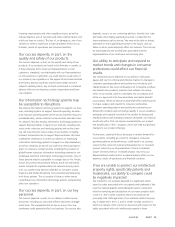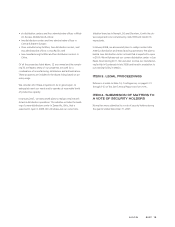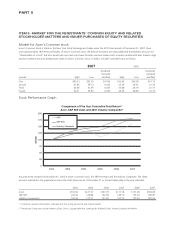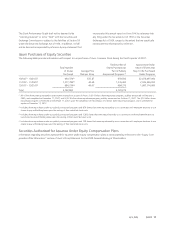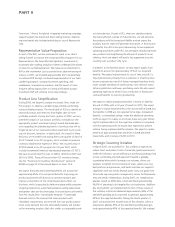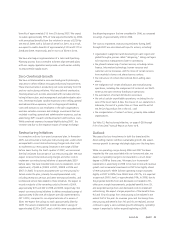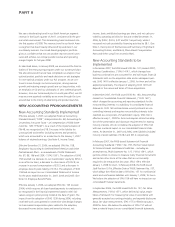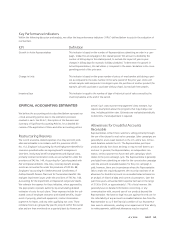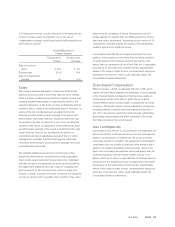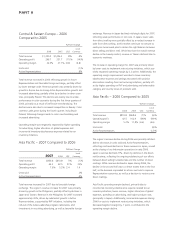Avon 2007 Annual Report Download - page 28
Download and view the complete annual report
Please find page 28 of the 2007 Avon annual report below. You can navigate through the pages in the report by either clicking on the pages listed below, or by using the keyword search tool below to find specific information within the annual report.PART II
We saw a decelerating trend in our North American segment
revenue in the fourth quarter of 2007, consistent with the gen-
eral retail environment. This decelerating trend continued into
the first quarter of 2008. The revenue trend in our North Amer-
ica segment has been heavily influenced by weakness in our
non-Beauty business. Our broad-based geographic portfolio
gives us confidence that we can weather macroeconomic pres-
sures and achieve our company-wide revenue and operating
margin targets for full year 2008.
As described above, in January 2008, we announced the final ini-
tiatives of the restructuring program under our turnaround plan.
We also announced that we have completed our analysis of our
optimal product portfolio and made decisions on exit strategies
for non-optimal products under our PLS program. As we con-
tinue to move through our turnaround plan, driving revenue
growth and restoring margin growth are our key priorities, with
an emphasis on SSI and our philosophy of zero overhead growth.
However, since our turnaround plan is a multi-year effort, we still
may see some quarterly variability as we move through the turn-
around due to the timing of advertising and product launches.
NEW ACCOUNTING PRONOUNCEMENTS
New Accounting Standards Implemented
Effective January 1, 2007, we adopted Financial Accounting
Standards Board (“FASB”) Interpretation No. 48, Accounting for
Uncertainty in Income Taxes – an interpretation of FASB State-
ment No. 109, (“FIN 48”). As a result of the implementation of
FIN 48, we recognized an $18.3 increase in the liability for
unrecognized tax benefits (including interest and penalties),
which was accounted for as a reduction to the January 1, 2007
balance of retained earnings. (See Note 6, Income Taxes).
Effective December 31, 2006, we adopted SFAS No. 158,
Employers’ Accounting for Defined Benefit Pension and Other
Postretirement Plans – an amendment of FASB Statements
No. 87, 88, 106 and 132R, (“SFAS 158”). The adoption of SFAS
158 resulted in a decrease to our shareholders’ equity by $254.7,
on an after-tax basis, a decrease to other assets of $232.8, an
increase in accrued compensation of $35.5 and a decrease in
employee benefit plans liability of $13.4. The adoption of SFAS
158 had no impact on our Consolidated Statement of Income
for the years ended December 31, 2007, 2006 and 2005. (See
Note 10, Employee Benefit Plans).
Effective January 1, 2006, we adopted SFAS No. 123 (revised
2004), which requires all share-based payments to employees to
be recognized in the financial statements based on their fair
values using an option-pricing model at the date of grant. The
impact from the adoption of SFAS 123R during 2006, including
restricted stock units granted in connection with design changes
to share-based compensation plans related to the adoption,
decreased income before taxes and minority interest, net
income, basic and diluted earnings per share, and net cash pro-
vided by operating activities for the year ended December 31,
2006, by $49.2, $32.4, $.07 and $8.1 respectively, while it
increased net cash provided by financing activities by $8.1. (See
Note 1, Description of the Business and Summary of Significant
Accounting Policies, and Note 8, Share-Based Compensation
Plans and Other Long-Term Incentive Plan).
New Accounting Standards to be
Implemented
In December 2007, the FASB issued SFAS No. 141 (revised 2007),
Business Combinations, (“SFAS 141R”), which changes how
business combinations are accounted for and will impact financial
statements both on the acquisition date and in subsequent peri-
ods. SFAS 141R is effective January 1, 2009, for Avon and will be
applied prospectively. The impact of adopting SFAS 141R will
depend on the nature and terms of future acquisitions.
In December 2007, the FASB issued SFAS No. 160, Noncontrolling
Interests in Consolidated Financial Statements, (“SFAS 160”),
which changes the accounting and reporting standards for the
noncontrolling interests in a subsidiary in consolidated financial
statements. SFAS 160 recharacterizes minority interests as non-
controlling interests and requires noncontrolling interests to be
classified as a component of shareholders’ equity. SFAS 160 is
effective January 1, 2009 for Avon and requires retroactive adop-
tion of the presentation and disclosure requirements for existing
minority interests. We do not believe the adoption of SFAS 160
will have a material impact on our consolidated financial state-
ments. At December 31, 2007 and 2006, other liabilities included
minority interest liabilities of $38.2 and $37.0, respectively.
In February 2007, the FASB issued Statement of Financial
Accounting Standards (“SFAS”) No. 159, The Fair Value Option
for Financial Assets and Financial Liabilities – including an
amendment to FASB Statement No. 115, (“SFAS 159”), which
permits entities to choose to measure many financial instruments
and certain other items at fair value that are not currently
required to be measured at fair value. SFAS 159 is effective
January 1, 2008 for Avon. In February 2008, the FASB issued
Staff Position 157-b, Effective Date of FASB Statement No. 157,
which delays the effective date of SFAS No. 157 for nonfinancial
assets and nonfinancial liabilities until January 1, 2009, for Avon.
We believe the adoption of SFAS 159 will have no impact on our
consolidated financial statements.
In September 2006, the FASB issued SFAS No. 157, Fair Value
Measurements, (“SFAS 157”), which defines fair value, estab-
lishes a framework for measuring fair value in accordance with
generally accepted accounting principles, and expands disclosures
about fair value measurements. SFAS 157 is effective January 1,
2008 for Avon. We believe the adoption of SFAS 157 will not
have a material impact on our consolidated financial statements.



